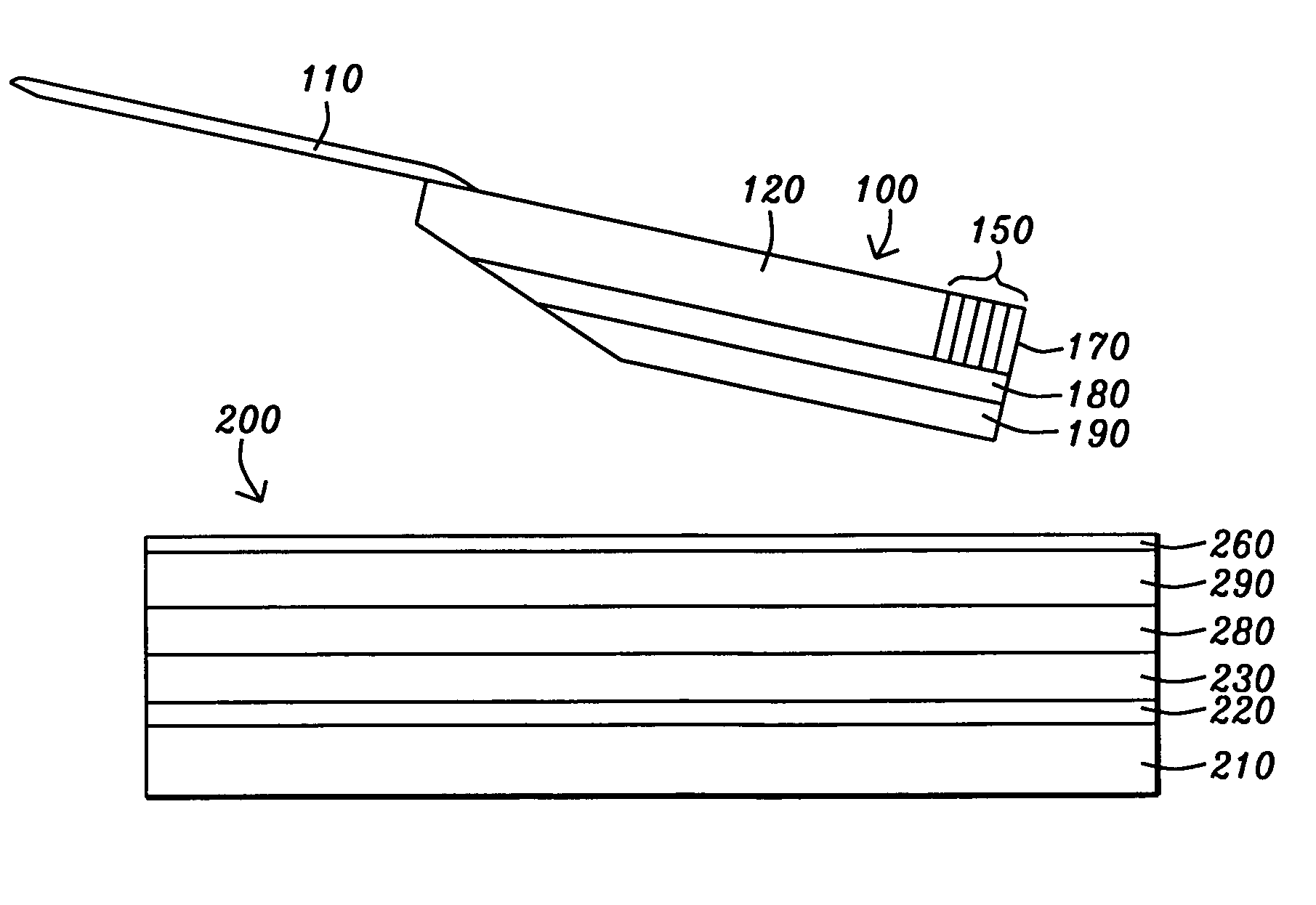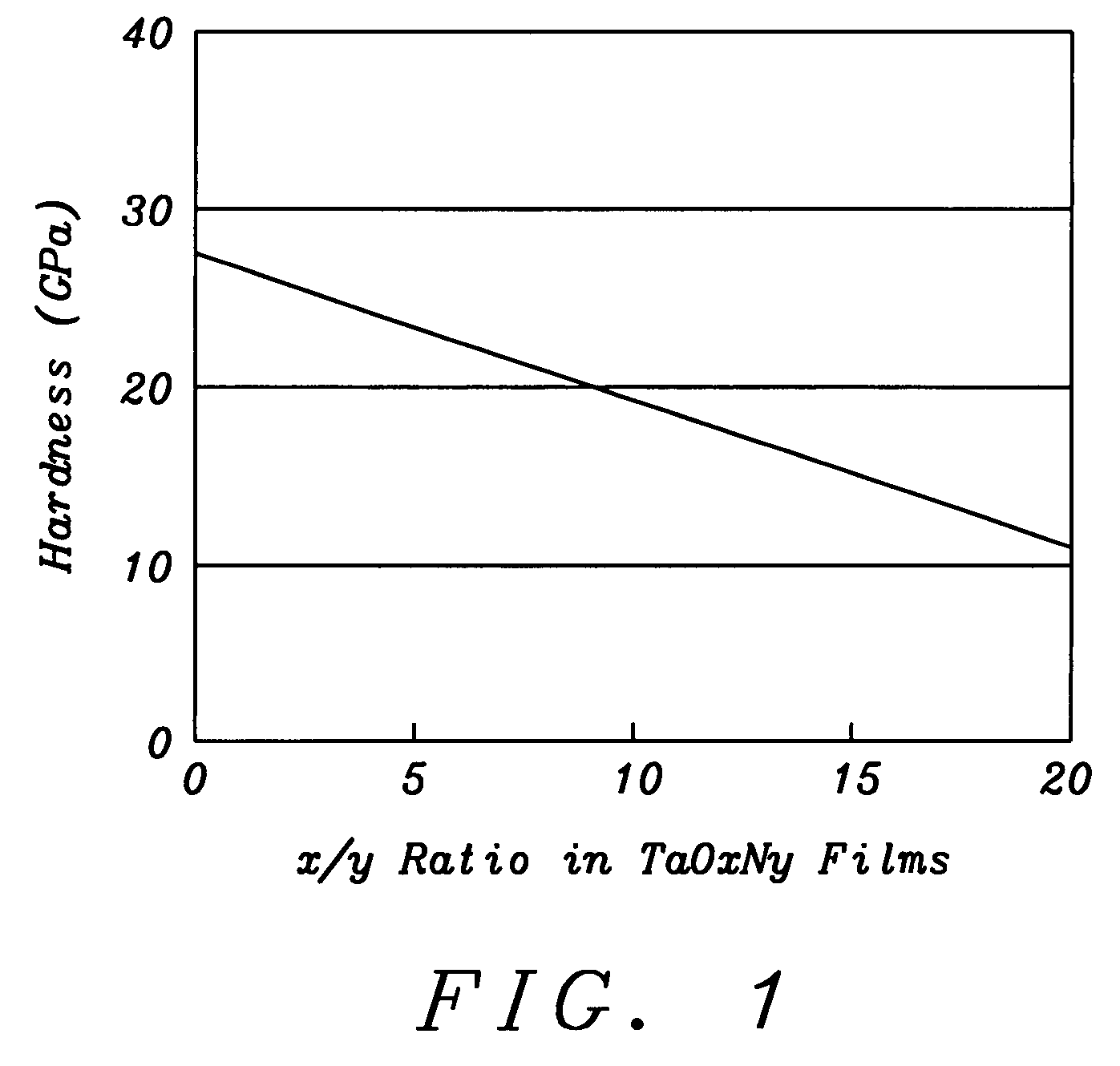Magnetic head/disk with transition metal oxynitride adhesion/corrosion barrier and diamond-like carbon overcoat bilayer
a technology of transition metal oxynitride and adhesion/corrosion barrier, which is applied in the direction of maintaining head carrier alignment, manufacturing head surface, instruments, etc., can solve the problems of unavoidable contact between the head and the disk surface, damage to the head and the disk, loss of recorded information on the disk,
- Summary
- Abstract
- Description
- Claims
- Application Information
AI Technical Summary
Benefits of technology
Problems solved by technology
Method used
Image
Examples
first preferred embodiment
[0043]Referring now to FIG. 5, there is shown a schematic perspective drawing of an apparatus within which the protective bilayer of the present invention can be formed on a magnetic read / write head or on the surface of a magnetic recording disk. In this first preferred embodiment, as an example of the method, the adhesion enhancing layer will be formed as a layer of TiOxNy.
[0044]The first preferred embodiment of this invention uses a deposition chamber (10) in which a vacuum of less than approximately 10−6 Torr has been formed by a turbo pump (not shown). This chamber is substantially a common element in all of the following embodiments. Into this chamber a reactive ion beam, such as an Ar+ beam (20) is injected and directed at a sputtering target of TiO2 (50). The beam is produced by a RF source (30) and accelerated by voltages that produce a beam of ions with a beam voltage between approximately 300 V to 1200 V. Injection ports (40) allow the injection of O2 and N2 gases into the...
second preferred embodiment
[0051]The second preferred embodiment of this invention uses the apparatus of FIG. 6, which is similar to that of FIG. 5 in that it comprises a deposition chamber (10) into which a reactive ion beam (20), such as an Ar+ ion beam, can be injected and directed at a Ti sputtering target (50), while injection ports (40) allow the injection of O2 and N2 gases with flow rates between approximately 0 and 20 sccm, and different concentration ratios and for different durations, depending upon the desired form of the x / y ratio in the TiOxNy underlayer, for x within the range of approximately 0 to 3 and y is within the range of approximately 0 to 2. In this embodiment, however, the reactive ion beam is a high energy scanning, focused Ar+ ion beam (25) that is directed at a sputtering target of Ti (50) and the sputtered atoms (60) impinge of the target read / write heads or a magnetic disk (70), which are mounted on a rotatable holder that is rotated for uniformity of the deposition. To avoid poi...
third preferred embodiment
[0054]The third preferred embodiment of this invention uses the apparatus of FIG. 7, which comprises a deposition chamber (10) into which a reactive ion beam, such as an Ar+ ion beam can be injected and directed at a Ti sputtering target (50) while injection ports (40) allow the injection of O2 and N2 gases with flow rates between approximately 0 and 20 sccm, and different concentration ratios and for different durations, depending upon the desired x / y ratio in the TiOxNy underlayer, for x within the range of 0 to 3 and y is within the range of 0 to 2. In this embodiment, however, the ion beam (20) is a pulsed Ar+ ion source with high instantaneous power, that is directed at a sputtering target of Ti (50) and the sputtered atoms (60) impinge on the deposition target read / write heads (70), which are mounted on a rotatable holder that is rotated for uniformity of the deposition. To avoid poisoning the target and to eliminate hysteresis effects associated with the deposition, there is ...
PUM
| Property | Measurement | Unit |
|---|---|---|
| thickness | aaaaa | aaaaa |
| thickness | aaaaa | aaaaa |
| height | aaaaa | aaaaa |
Abstract
Description
Claims
Application Information
 Login to View More
Login to View More - R&D
- Intellectual Property
- Life Sciences
- Materials
- Tech Scout
- Unparalleled Data Quality
- Higher Quality Content
- 60% Fewer Hallucinations
Browse by: Latest US Patents, China's latest patents, Technical Efficacy Thesaurus, Application Domain, Technology Topic, Popular Technical Reports.
© 2025 PatSnap. All rights reserved.Legal|Privacy policy|Modern Slavery Act Transparency Statement|Sitemap|About US| Contact US: help@patsnap.com



